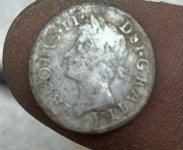I spent some hours chipping off major rust from an axe head and a hatchet head. I plan to continue to try to get to original surface once I build an electrolysis machine. I checked the internet. I believe the large head is a swamping or felling axe blade. I can not see any tell tale stamping or makers marks. So the question is how can I tell if these are hand forged (older) or mass produced (younger) axe heads?
The large blade measures 8 1/2 inches length wise. I inserted a photo of where it was when I found it (rusty).








The large blade measures 8 1/2 inches length wise. I inserted a photo of where it was when I found it (rusty).




